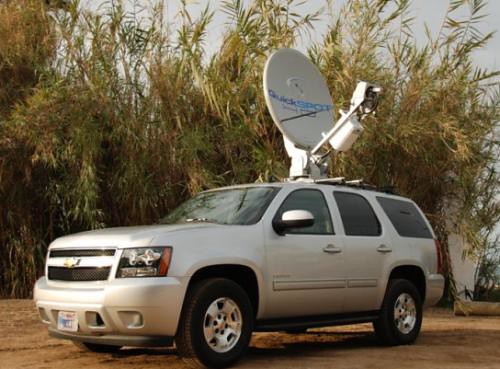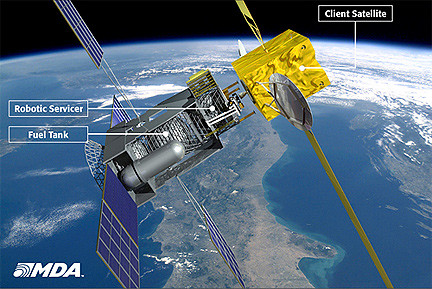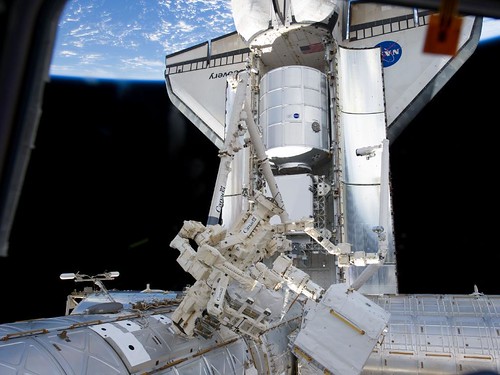ATTENDING SATELLITE 2011? Send me an email if you’d like to meet. Bill
NASA climate satellite fails to reach orbit as nose cone fails to separate on time, dooming the $424m Glory mission.
[Space on msnbc – 03/04/2011]
Air Force’s second launch of secret X-37B space plane set for today; likely to test spy satellite technology.
[Fox News – 03/04/2011]
EGNOS Safety-of-Life signal formally declared available to aviation; for first time space-based navigation signals officially usable for critical task of vertically guiding aircraft during landing approaches.
[SatNews – 03/04/2011]
EADS signs Memorandum of Understanding with Skolkovo Foundation on research collaboration, formalizing EADS intention to establish research center in Skolkovo Innovation Centre in Moscow.
[SatNews – 03/04/2011]
General Dynamics C4 Systems gets NASA contract to implement additional flexibility, replace aging equipment, and bring new capabilities to the ground segment of the TDRS Satcom system.
[SatNews – 03/04/2011]
ViaSat restructures YahSat deal to extend its Ku-band international mobility coverage to include Ka-band.
[Satellite Today – 03/04/2011]
Shuttle booster-mounted camera provides never before seen view of shuttle launch – NASA video.
[R&D Magazine – 03/04/2011]
NewCom Unveils Internet-Based Rural Education Package via Satellite for Latin America, Africa.
[PR Web – 03/04/2011]
Yahsat schedules launch of its first satellite, Y1A, for March 30.
[Trade Arabia – 03/04/2011]
Russia’s upper house of parliament ratifies new agreement with Ukraine for protection of rocket and space technology.
[SatNews – 03/04/2011]
AsiaSat launches DVB-S2 DTH platform on AsiaSat 4 for Australian and New Zealand audiences; SES WORLD SKIES renews service of three NSS-11 transponders to provide pay TV services in Hong Kong.
[SatNews – 03/04/2011]
Iridium provides satellite communications for 2011 Iditarod sled dog race safety.
[Globe Newswire – 03/04/2011]
SST Online provides new apps for iPad and iPhone allowing users including fishermen to interact with navigational charts and GPS positioning.
[SatNews – 03/04/2011]
Vroon selects KVH TracPhone V7 and Mini-VSAT broadband service for 125+ vessels.
[Globe Newswire – 03/04/2011]
Latitude announces two new control and displahy units to support their SkyNode line of satellite data and telephone systems.
[SatNews – 03/04/2011]
India’s space program becoming increasingly militarized, with interest in developing anti-satellite weapons.
[SatNews – 03/03/2011]
China to develop GPS system by 2020.
[Satellite Today – 03/03/2011]
WTA to announce Teleport Awards for Excellence March 15 at Satellite 2011.
[SatNews – 03/03/2011]
Former commercial DC-8 in service for NASA for over 25 years deployed as airborne science laboratory to observe launch of Glory satellite from Vandenberg.
[Washington DC Examiner – 03/03/2011]
Spaceflight activity in New Mexico gains momentum as the governor appoints retired Air Force official to head up the Spaceport Authority and Virgin Galactic’s first customer signs on.
[SatNews – 03/03/2011]
Harris Corp is awarded contract from Boeing Space & Intelligence Systems to build antennas for three Inmarsat-5 satellites.
[Biz Journals – 03/03/2011]
Telesat announces agreement with Loral Space & Communications to acquire the Canadian payload of the ViaSat-1 satellite.
[SatNews – 03/03/2011]
France’s International Space University will hold 25th annual Space Studies Program in Florida, USA from June through August 2011.
[SatNews – 03/03/2011]
DirecTV professes that, while it has begun to resell broadband service from its partners AT&T and Verizon, it has no plans to acquire additional spectrum like Echostar and compete with Telcos.
[Connected Planet – 03/03/2011]
Harbinger Capital Partners, backer of LightSquared, bids on bankrupt satellite company DBSD together with Solus Alternative Asset Management.
[Wireless Week – 03/03/2011]
Hughes, which recently agreed to be acquired by Echostar, sees profits for latest quarter rise.
[Washington Business Journal – 03/03/2011]
Viasat builds on success of global mobile satellite networking business at Ku-band by expanding into Ka band in key markets, including airborne.
[PR Newswire – 03/03/2011]
Starmax HD selects GlobeCast end-to-end services for Spanish distribution.
[Satellite Today – 03/02/2011]
AT&T claims to be America’s fastest-growing TV provider, beating growth of Satellite, Cable, and other providers.
[vision2mobile – 03/03/82011]
Thales Alenia creates separately owned German Subsidiary, Thales Alenia Space Deutschland GmbH in Stuttgart area in order to play a growing role in Germany.
[SatNews – 03/02/2011]
SES successfully places E650m 10-year Euro bond.
[Business Wire – 03/02/2011]
Loral Space & Communications gets $1.5m contract from US Air Force to study technology the military might use to communicate during future wars.
[Forbes – 03/02/2011]
US Army satellite control facilities move from Camp Roberts in California to the Joint Base Pearl Harbor-Hickam in Hawaii.
[SatNews – 03/02/2011]
The Federal Communications Commission is expected to review rules governing fees that satellite and cable companies pay TV stations to retransmit their signals.
[Washington Post – 03/02/2011]
Plans for combining satellite and cellular Access in new mobile phones, like the LightSquared LTE network being built, worry those in the GPS industry.
[Kansas City The Star blog – 03/02/2011]
Libya accused of jamming satellite signals of Thuraya and Al Jazeera.
[Mother Nature Network – 03/02/2011]
American contractor jailed in Cuba on charges of brining in illegal satellite communications equipment and setting up internet access in violation of Cuban law.
[Reuters – 03/02/2011]
Dispute between LIN Media and Dish Network regarding retransmission fees may be added ammunition for reform advocates four days before FCC review of rules begins.
[Ad Week – 03/02/2011]
NAB asks Congress to investigate alleged spectrum hoarding by Dish Network and Time Warner Cable.
[Wireless Week – 03/01/2011]
LightSquared and the United States Global Positioning System Industry Council file joint report as required by FCC, outlining analyses they plan to conduct together.
[SatNews – 03/01/2011]
TSF deploys humanitarian calling operations at entrance to transit camp between Tunisia and Libya in collaboration with Tunisian Red Crescent and International Red Cross.
[SatNews – 03/01/2011]
Ericsson releases MPEG-4 Voyager 2 Satellite Newsgathering product.
[Satellite Today – 03/01/2011]
Retransmission fees fight in Canada heads to Supreme Court on appeal by Rogers Communications.
[Winnipeg Free Press – 03/01/2011]
Harbinger restructures LightSquared holding to make direct investments easier.
[Reuters – 03/01/2011]
Noteholders of DBSD North America file reorganization plan for bankrupt satellite communications company in case proposed acquisition by Echostar fails to
occur.
[Denver Post – 03/01/2011]
Segovia Executives to open and close panel sessions at Satellite 2011, speaking about new technologies, innovations in MSS, and satellite industry
challenges in the year ahead.
[PR Newswire – 03/01/2011]
MTN Executives to speak at Satellite 2011 on introduction of Ka-band to the Maritime industry and Disaster Relief Coordination.
[PR Newswire – 03/01/2011]
UniSat provides end-to-end managed VSAT network service to US Army in Afghanistan.
[Business Wire – 03/01/2011]
NSR Report projects oil & gas via satellite market will reach nearly $1B by 2020.
[NSR Press Release – 03/01/2011]
Vizada Networks implements iDirect-based VSAT infrastructure in Europe for large Civil Defense agency.
[PR Newswire – 02/28/2011]
Newtec signs deal with NPO SvyazProekt of Russia, certifying it as Newtec’s first authorised repair centre in Eastern Europe.
[realwire – 02/28/2011]
Libyan authorities jam RT’s Arabic channel Rusiya al-Yaum, broadcast in Libya via the Nilesat (AB4) satellite.
[PR Newswire – 02/28/2011]
Following approval of Belgium, all of member states of EUMETSAT are now firmly commited to Meteosat Third Generation program.
[SatNews – 02/28/2011]
GLONASS system begins operation on Vladivostok’s municipal transport system.
[ITAR-TASS – 02/28/2011]
ORBIT awarded IDIQ contract by US Army for Airborne voice altitude warning systems for combat deployed Blackhawk helicopters.
[The Street – 02/28/2011]
Sea Ray, manufacturer of pleasure boats and yachts, names KVH Industries (TracVision antennas and miniVSAT broadband) its exclusive satellite partner for the next three years.
[SatNews – 02/28/2011]
SkyTrac Systems to launch SkyWeb Mobile for iPho0ne, Blackberry, and Android which will display curent position and flight data for aircraft equipped with
SkyTrac’s hardware solutions.
[SatNews – 02/28/2011]
AT&T to launch "Geo-fencing" using Placecast technology and GPS data to target marketing to consumers based on their location.
[Satellite Spotlight – 02/28/2011]
Satellite operators pursue mobile backhaul market – besides current operators, Hylas 1 will also look at backhaul, O3b is planning launches, and Microsat Systems Canada intends to build a LEO constellation of 84 Ka-band satellites for commercial backhaul services.
[Satellite Markets – March 2011]
WBMSAT PS satellite communications systems services












